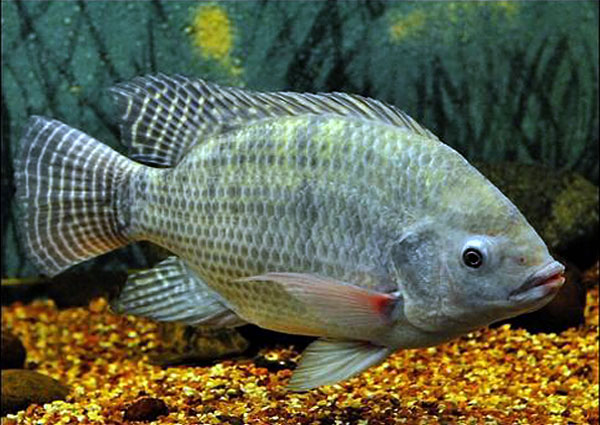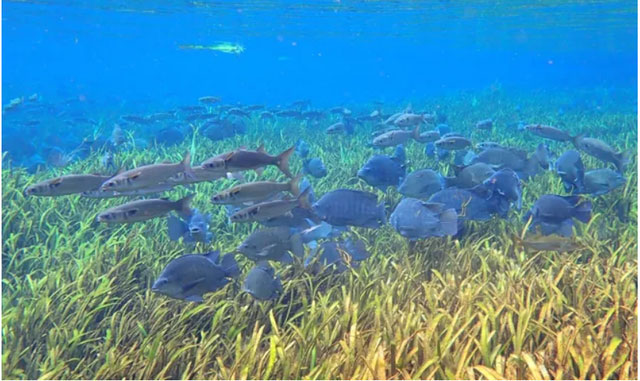A species of fish in Asia that has been frozen for 2 years is still alive and walking on land, causing the US to 'turn on' the alarm
US state authorities are concerned that the presence of this fish has caused great damage since they were introduced locally .
Severe damage caused by a single fish species
The Nevada Department of Wildlife has issued an alert warning about an alien fish that has surprised many people because they are very familiar to many Asians. After this policy is implemented, live blue tilapia will not be allowed to be consumed in Las Vegas, Nevada, USA. Surprisingly, the Florida government also made a similar announcement. According to the authorities of these places, blue tilapia after being released into local waterways has caused significant environmental and economic damage. Why did these states "issue" an alert about blue tilapia?

The familiar fish in Asia that has caused alarm in the US is the blue tilapia. (Photo: Pixabay)
Blue tilapia were originally introduced into the United States in an effort to control aquatic vegetation in fish farms and lakes. However, they have since become invasive in many states, including Florida and Texas. They compete for food, space, and outcompete native species. Fish communities have been affected by invasive species, leading to a threat to genetic diversity among fish as they hybridize with other species in their genus.
Additionally, blue tilapia reproduce at an alarming rate . Specifically, in the Muddy River system, where blue tilapia nearly drove a native fish species to extinction, a costly five-year eradication program costing more than $600,000 was required.

Blue tilapia is an alien fish species that competes with native fish for food and space. (Photo: Pixabay)
In addition to causing environmental damage, banning blue tilapia farming also causes huge losses for fish businesses. Tilapia that cannot be sold fresh will lose much of its value and appeal to customers. Finding a replacement fish that can be sold live can take up to a year, as it requires setting up a farm, raising the fish, and undergoing inspections before they can be marketed, causing many difficulties for businesses. State governments have warned that the "invasion" of blue tilapia could cause millions of dollars in damage to the US economy.
Scary alien fish
Blue tilapia (Oreochromis aureus) is a species of tilapia and is native to West Africa and the Middle East. This species has economic value and has been introduced to many places and developed into an invasive species.
Blue tilapia has a slightly purple body, shiny scales, with 9-12 dark parallel stripes from back to belly. The caudal fin has dark black stripes parallel from top to bottom and distributed throughout the caudal fin. The dorsal fin has white stripes running parallel on a dark gray background. The dorsal and caudal fin edges are light pink. Blue tilapia can be up to 0.6m long and weigh 4kg. Monosex tilapia (male) grow quickly, after 4-5 months of raising, they can reach a weight of 0.4-0.6kg/fish. There are different growth rates between males and females. Usually, males grow 15-18% faster than females after 4 months of raising.

Blue tilapia is an invasive fish species that causes great environmental and economic damage to the United States. (Photo: Pixabay)
Blue tilapia can eat most natural foods, organic debris in the pond, tilapia not only destroys small animals carrying pathogens but also cleans the environment and produces valuable products. When young, they mainly eat plankton (algae and small animals) (20-day-old fish, about 18mm in size).
When the fish are mature, they eat organic detritus and algae that settle at the bottom of the pond, eat larvae, insects, and aquatic plants. However, in industrial farming, fish also eat foods made from trash fish, crabs, snails, dried fish meal, corn flour, cassava flour, sweet potatoes, rice flour, fine bran, soybean meal, and peanut meal. In nature, fish usually eat from the bottom layer at a depth of 1-2m. Every year, blue tilapia can lay eggs 6-11 times. Female fish lay about 200 eggs each time in a self-made nest, then the male fertilizes the eggs. The parents keep the eggs and fry in their mouths for about 2 weeks. The male digs the nest, the female tilapia incubates the eggs in her mouth. After the eggs are fertilized, the fish holds them in its mouth until they hatch, each time laying 1,000 - 2,000 eggs and laying many times.

Blue tilapia can withstand temperatures up to 42 degrees Celsius and cold temperatures down to 11 degrees Celsius. (Photo: Pixabay)
Blue tilapia is easy to raise and can withstand unfavorable environments. It can live in fresh water, brackish water (which can have a salinity of up to 32%o) and even slightly acidic water. Fish are generally afraid of dirty water, but tilapia can withstand water with an ammonia content of up to 2.4 mg/l and an oxygen content of only 1 mg/l. It can withstand temperatures up to 42 degrees Celsius and cold temperatures up to 11 degrees Celsius. The pH limit for them is from 5-10.
In addition, experts at James Cook University, Australia have discovered that this fish can "walk". They can crawl across islands in the Torres Strait without water for up to 6 days. The reason is that blue tilapia have air-breathing organs. During drier times, they will burrow deep into the mud to survive. Blue tilapia can move around on land using their pectoral fins and they can even climb trees. Although they are native to freshwater, this fish can also live in salt water.
In Australia, blue tilapia is also a threat to native fish species. Tilapia can be dangerous to birds. They have the ability to strangle birds with their gills.

This tilapia can also walk on land and go without water for up to 6 days. (Photo: Pixabay)
Previously, Chinese media caused a stir after posting a video of a tilapia fish reviving after being frozen for 2 years at -32 degrees Celsius. Scientists explained that the reason why the fish could revive was thanks to a protein called AFP - Antifreeze protein. This protein has the effect of preventing the death of cells when organisms are frozen. AFP protein will stick to ice crystals in cells, preventing the growth, spread, and crystallization of ice to protect the cells. At the same time, the cytoplasm also becomes thicker, making it harder to freeze. That is also the reason why a tilapia fish can survive even when frozen.
With such special abilities, blue tilapia has made scientists worry that if they do not prepare a good plan to deal with this fish species, the damage that the US and Australia will have to suffer will be much higher.
- Strangely, fishes like to walk on land
- Fish know to walk in the Himalayas
- Walking fish and terrestrial evolutionary origin
- Marvel at fish that can live 6 days on land
- Discover a rare hand-walking fish species in the Tasmanian sea floor
- Video: The sight of fish walking in the sea
- Frozen frozen fish revived after two seconds into the basin
- The tiny tree climbing fish species is researched, preserved and developed by Ca Mau
- It was the turn of the fish to freeze in the air because it was too cold
- Find fish jumping on land to hunt
- See exotic fishes in the East India coral reef
- Fish walking in the seabed of Indonesia
 Animal 'suffering' after hibernation
Animal 'suffering' after hibernation Why do goats climb well?
Why do goats climb well? Scientists were surprised to see chimpanzees eating turtles
Scientists were surprised to see chimpanzees eating turtles Giant catfish died deadly due to drought in Thailand
Giant catfish died deadly due to drought in Thailand